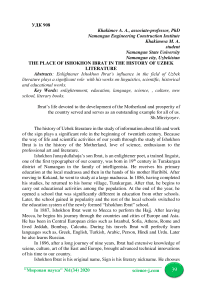The place of Ishokhon Ibrat in the history of Uzbek literature
Автор: Khakimov A.A., Khakimova M.A.
Журнал: Мировая наука @science-j
Рубрика: Основной раздел
Статья в выпуске: 1 (34), 2020 года.
Бесплатный доступ
Enlightener Ishokhon Ibrat’s influence in the field of Uzbek literature plays a significant role with his works on linguistics, scientific, historical and educational works.
Enlightenment, education, language, science, culture, new school, literary books
Короткий адрес: https://sciup.org/140265001
IDR: 140265001 | УДК: 908
Текст научной статьи The place of Ishokhon Ibrat in the history of Uzbek literature
Ibrat’s life devoted to the development of the Motherland and prosperity of the country served and serves as an outstanding example for all of us. Sh.Mirziyoyev.
The history of Uzbek literature in the study of information about life and work of the sign plays a significant role in the beginning of twentieth century. Because the way of life and scientific activities of our youth through the study of Ishokhon Ibrat is in the history of the Motherland, love of science, enthusiasm to the professional art and literature.
Ishokhon Junaydullahoja’s son Ibrat, is an enlightener poet, a trained linguist, one of the first typographer of our country, was born in 19th century in Turakurgan district of Namangan in the family of intelligentsia. He receives his primary education at the local madrassa and then in the hands of his mother Huribibi. After moving to Kokand, he went to study at a large madrassa. In 1886, having completed his studies, he returned to his home village, Turakurgan. After that, he begins to carry out educational activities among the population. At the end of the year, he opened a school that was significantly different in education from other schools. Later, the school gained in popularity and the rest of the local schools switched to the education system of the newly formed “Ishokhon Ibrat” school.
In 1887, Ishokhon Ibrat went to Mecca to perform the Hajj. After leaving Mecca, he begins his journey through the countries and cities of Europe and Asia. He has been in Central European cities such as Istanbul, Sofia, Athens, Rome and lived Jeddah, Bombay, Calcutta. During his travels Ibrat will perfectly learn languages such as, Greek, English, Turkish, Arabic, Person, Hindi and Urdu. Later he also learns Russian.
In 1896, after a long journey of nine years, Ibrat had extensive knowledge of sciene, culture, art of the East and Europe, brought advanced technical innovations of his time to our country.
Ishokhon Ibrat is his original name, Sign is his literary nickname. He chooses
it due to signing out advanced news, the worlds science and culture created himself from his people and enjoy them live intensely in each work.
In 1901, he finished his work under the title “Lugati sitta-alsina” (dictionary of six languages) and published it. It served as a unique guide in all Jadidist schools to learn Russian, Arabic, Persian, Indian, Turkish and Uzbek words.
In 1907, Ishokhon Ibrat organized a new school “Usuli Savtia”, in which he taught rural children and further he opened in the name “Library of Isaac”.
As one of the printers in our country, Ibrat bought a lithographic machine in Orenburg in 1908, took it by train to Kokand, then on camels to Turakurgan and opened “Ishokiya” printing office in his house. Scientific-enlightenment books, brochures, a national newspaper published there, dozen of book-stores were opened for their distribution throughout the Ferghana valley.
In 1912, Ibrat finished his work on the history of writing languages under the name “Jome ul-Khutut” and published a book in the editorial under the name “Matbaai Ishokiya”
To honour the name of the enlightener the 14th secondary school in the Turakurgan district of the Namangan region and a street in Toshkent are named after the poet’s name. A large-scale creative work was carried out over the past period in the memorial complex Ishokhon Tura Ibrat. The complex includes the garden, in the centre of which there is a monument to Ishokhon Ibrat, a printing house, a musicial fountain, a specialized-400-seat-boarding school in learning foreign languages and a museum located in historical architectural building. The museum will acquaint visitors with the life and multifaceted works of Ibrat. All these objects, united in a single complex, will play an important role in promoting the great merits of the enlightener and studying his heritage.
Список литературы The place of Ishokhon Ibrat in the history of Uzbek literature
- Alikhon Halilbekov. Namangan adabiy muhiti.-Tashkent:Ruhafzo. 1998. P-156.
- Ishokhon Ibrat. Ilmi Ibrat. Matbaai Ishokiya. - Turakurgan. 1909.
- Ishokhon Ibrat. Sanati Ibrat, Matbaai Ishokiya, - Turakurgan. 1908.
- Ishokhon Ibrat. Lugati sittati alsinna. T.: Ilin typography, 1901.
- Ishokhon Ibrat. History of Ferghana. 1916.


